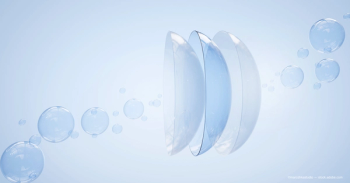
Report promotes step therapy approach to dry eye disease management
Study offering physicians new and innovative ways to approach DED
The Tear Film and Ocular Surface Society Dry Eye Workshop II report recommends a comprehensive, multistage management algorithm for the disease that is both evidence-based and personalized.
For patients suffering from
The 2017
The cycle of tear film instability and hyperosmolarity creates ocular surface inflammation, damage, and neurosensory abnormalities1 that can frustrate both patients and clinicians. The report recommends a comprehensive, multistage management algorithm for DED that is both evidence-based and personalized, depending on the severity of the disease.
The goal of DED treatment is to restore the homeostasis of the ocular surface and tear film.
The TFOS DEWS II now defines DED as a multifactorial disease of the ocular surface characterized by a loss of homeostasis of the tear film, and accompanied by ocular symptoms, in which tear film instability and hyperosmolarity, ocular surface inflammation and damage, and neurosensory abnormalities play etiological roles.
The TFOS DEWS II recognizes that management algorithms are more complicated in DED than in other diseases, because DED can vary greatly from one patient to another.
RELATED:
Education and lifestyle modifications
Based on patient symptomatology or clinical signs of DED, the first step is to educate the patient on the severity and chronic nature of the disease. It is believed that patient compliance improves once the patient is better educated about his or her disease.2
Once patients understand why the management of DED is key to preventing its progression, and to improve overall patient comfort, the report recommends suggesting environmental, and lifestyle changes. This may include introducing essential fatty acid oral supplements to patients’ diets, and modifying environmental humidity. It also can include dependency on contact lenses, screen time/computer usage, and sun exposure.
Medications may also need to be modified, with the potential elimination of DED-inducing drugs such as antihistamines and decongestants. This may include other medications that may cause, contribute to, or aggravate DED. It also could include hormone therapy drugs, antihypertensives, anticholinergics, antineoplastics, and some analgesics.
The patient should be prescribed artificial tears. If present, signs of
RELATED:
In-office treatments and prescription drugs
If the strategies in Step 1 do not improve DED, TFOS DEWS II recommends a second step that intensifies therapy to prescription medications and in-office treatments.
Prescription medications can include topical antibiotics or antibiotics with steroids for patients with anterior blepharitis, and anti-inflammatory agents (topical lifitegrast and cyclosporine) specifically designed for DED.
Preservative-free ocular lubricants are also recommended, as preservatives can cause ocular toxicity in some patients. The group also cautions that the use of prescription drugs needs to be considered in the context of the individual patient presentation since the mechanism of action varies widely among the classes.
If the patient has MGD and warm compresses have not provided relief, patients may benefit from in-office, device-assisted expression with LipiFlow (Johnson & Johnson Vision) or intense pulsed light (IPL) therapy. LipiFlow takes about 12 minutes and has lasting effects of one year or more with a single treatment.3 IPL needs to be repeated every five to six weeks, and is best used as an adjunctive treatment. Data indicate it does improve tear break-up time.4
Tear conservation with moisture chamber glasses/goggles has been shown to improve blink rates and tear film stability, especially in patients living in environments with low humidity.5 Clinicians should be aware that patients may resist that treatment recommendation for cosmetic reasons.
Therapeutic contacts and oral medications
In the third step, for patients with more severe DED, oral secretagogues, such as pilocarpine or cevimeline, or autologous/allogeneic serum (AS) eye drops may be helpful. AS tears are more effective than traditional tears in decreasing dry eye symptoms and improving tear film stability6 but are challenging to produce.
Patients must not have any blood-borne infectious conditions and their blood must be drawn regularly. AS drops are also expensive and not always covered by insurance.
Therapeutic contact lenses, such as soft bandage and rigid scleral lenses, are another option for patients with severe DED who have failed all previous treatments, or in whom treatment has not alleviated symptoms. Although these lenses are generally efficacious and well tolerated, clinicians should exercise caution due to the risk of infection.7
Surgical approaches
In the fourth step, surgical intervention may become necessary. Although rare, patients who experience corneal injuries and subsequent vision loss may need additional interventions such as amniotic membrane grafts, surgical punctal occlusion, tarsorrhaphy, or salivary gland transplantation.
Topical corticosteroids should also be considered for a longer duration (but bear in mind long-term use of topical corticosteroids can lead to an IOP increase and/or early cataract formation). These interventions are recommended only for the most extreme dry eye cases.
The incidence of DED is increasing, and patients are experiencing dry eye symptoms at younger ages. Fully understanding the TFOS DEWS II DED management recommendations can be a key component to proper treatment.
References:
1. Craig JP, Nelson JD, Azar DT, et al. TFOS DEWS II Report Executive Summary. Ocul Surf. 2017;15(4):802-12.
2. Hill J, Bird H, Johnson S. Effect of patient education on adherence to drug treatment for rheumatoid arthritis: a randomised controlled trial. Ann Rheum Dis. 2001;60(9):869-75.
3. Blackie CA, Coleman CA, Holland EJ. The sustained effect (12 months) of a single-dose vectored thermal pulsation procedure for meibomian gland dysfunction and evaporative dry eye. Clin Ophthalmol. 2016;10:1385-96.
4. Toyos R, McGill W, Briscoe D. Intense pulsed light treatment for dry eye disease due to meibomian gland dysfunction; a 3-year retrospective study. Photomed Laser Surg 2015;33(1):41-6.
5. Ogawa M, Dogru M, Toriyama N, et al. Evaluation of the Effect of Moist Chamber Spectacles in Patients With Dry Eye Exposed to Adverse Environment Conditions. Eye Contact Lens 2018;44(6):379-83.
6. Jirsova K, Brejchova K, Krabcova I, et al. The application of autologous serum eye drops in severe dry eye patients; subjective and objective parameters before and after treatment. Curr Eye Res. 2014;39(1):21-30.
7. Bavinger JC, DeLoss K, Mian SI. Scleral lens use in dry eye syndrome. Curr Opin Ophthalmol. 2015;26(4):319-24.
Newsletter
Don’t miss out—get Ophthalmology Times updates on the latest clinical advancements and expert interviews, straight to your inbox.













































